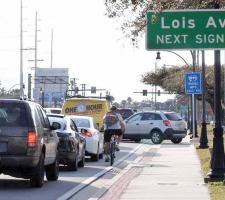
Connected vehicle technology will emerge as a sustainable reality at three sites in the US over the next four years. Jon Masters reports.
Advocates of connected vehicle (CV) technology have received a welcome boost from news that the US government has committed a further $4 billion towards automated vehicle research and CV technology. This comes hot on the heels of the
While the latest $4 billion is a long-term figure for use across a wide range of research and development subjects, USDOT’s October 2015 announcement confirmed the award of $42 million in grants for three CV pilot projects. Bidders from New York City, Wyoming and Tampa in Florida had been chosen to develop the first CV applications that will operate at street level.
The US appears to have stolen a march on the rest of the world with its federally funded, government-led efforts to develop CV technology. Engineering teams attached to authorities at each pilot site are in the ‘concept development’ phase, which is expected to take about a year and will be followed by design, deployment and testing (about 20 months) culminating in around 18 months of operation and maintenance.
By that time the CV applications should be up and running, support from USDOT will end and the pilot teams will be on their own. In reality, however, by that stage – around four years from now – a number of other transportation authorities may be developing their own CV projects and a new sector of ITS industry expertise will be maturing.
For now, USDOT is providing significant engineering support to ensure the teams avoid pitfalls in certain key areas during concept development. Support material makes it clear that while all three sites can consider themselves successful in getting this far, each has to demonstrate they’re ready for phases two and three.
“Funding decisions for later phases are dependent on the strength of conceptual development at each individual site,” says Kate Hartman, CV pilots programme manager for USDOT’s ITS Joint Program Office (JPO).
The JPO also makes clear that the pilot sites have just this year to get key plans and tasks of concept development finished on time and within budget. They’re being actively encouraged to engage regularly with a network of USDOT support staff and each other.
A series of advisory webinars was held in December 2015, in association with ITS America. The first of these, on preparing a safety management plan, was presented by John Harding, ITS research specialist for the National Highway Traffic Safety Administration (NHTSA).
Safety plans
Developing a safety management plan will be very involved for each of the pilot sites, requiring consideration of safety scenarios through a risk assessment approach on the way to producing a ‘safety operational concept’.
“The principle is safety through design, from the very start and with ongoing safety management,” Harding says. “One important piece of advice is to involve a group of people with different knowledge relevant to the particular site and pilot project. That way, all of the scenarios that could possibly happen can be identified and addressed.”
In another webinar in the series, NHTSA’s program manager Kevin Gay described the essential requirements for developing security operational concepts. Each deployment site will be drawing up how they intend to manage physical, access and communications security. All are important in any security concept, but the last of these is particularly crucial, through adoption of a security certificate management system or SCMS, says Gay.
“All messages from infrastructure and vehicle must be trusted as bonafide and accurate for the system to work. Messages need proven authenticity and integrity and have to be proven without compromising privacy. We’ve designed an outline system that meets all of these requirements,” he adds.
Essentially the infrastructure and vehicles will generate public and private ‘key pairs’ which will be sent to a certification authority. This will generate and send a certificate to allow the device to authenticate messages. Gay also described a process of bootstrapping for enrolling and authenticating all new vehicles and devices into CV systems via an SCMS.
“There are other ways of doing bootstrapping. It’s possible for vehicles and devices to request and generate certificates themselves but this requires a high level of sophistication and expertise. USDOT will need to authenticate devices’ and vehicles’ participation in the pilots. At present we’re supporting a central SCMS approach,” Gay says. The first functional SCMS is expected to be released for testing imminently, with further versions to follow in March and June.
Business cases
The third webinar focused on the institutional and financial issues of CV technology in operation to ensure systems have a valid and sustainable business case and can be operated through successful partnerships.“We are now taking CV research into deployment in the marketplace,” says Brian Cronin, ITS JPO team leader for research and development. “We want to spur the industry to produce products and services that support this initiative.
“We want to measure the benefits – safety, mobility and environmental – and resolve any technical, financial and institutional difficulties. We want to work with the pilot sites to make sure the technology can be advanced and make the business case for CV technology to be deployed nationwide by all transport authorities.”
The USDOT programme of technical support continues, and past and future webinars will be made available on the ITS JPO website.
New York City’s CV pilot project will see vehicle to vehicle (V2V) and vehicle to infrastructure (V2I) technology installed in city-owned cars, buses and trucks and other controlled fleets. Up to 10,000 vehicles could be equipped according to the New York Department of Transportation.
Three road corridors will be equipped with V2I infrastructure: four avenues of the Manhattan grid between 14th and 67th streets; FDR Drive on the outskirts of Manhattan; and Flatbush Avenue in Brooklyn.
The objectives are closely aligned with NYC’s Vision Zero initiative for reducing pedestrian injuries and fatalities and making the city’s streets safer for all travellers. CV applications planned for the pilot include automatic warning of red light violation, ‘pedestrian on crosswalk’ and ‘vehicle turning right in front’.
Other proposed applications include a Mobile Accessible Pedestrian Signal System (providing automatic communication between traffic signals and visually impaired pedestrians) and a system providing dynamic information to commercial fleets to improving freight movements through the city.
Tampa’s CV pilot is centred on the city’s CV technology test bed and will focus on tackling peak hour traffic congestion, improving traffic flow and pedestrian safety. Tampa will also measure the environmental benefits of using CV technology.
The project, which is being led by the Tampa-Hillsborough Expressway Authority (THEA), will deploy a variety of connected vehicle technologies within the vicinity of the Selmon Expressway where it snakes across central Tampa. This area contains a number of junctions between the expressway and the surrounding road network with high pedestrian densities and variable traffic demand.
Drivers experience significant delays during peak periods, and there are a large number of rear-end crashes and red light running collisions. The area is also prone to signal coordination issues.
The main aim of the THEA pilot deployment is to alleviate congestion and safety issues during the morning peak. A variety of V2V and V2I applications are proposed, including (V2I) curve speed warning, pedestrian on signalised crosswalk and mobile accessible pedestrian signal. Intelligent traffic signal and transit priority systems will be deployed at a number of intersections on the city’s street grid.
V2V safety applications to be piloted are emergency electronic brake light, forward collision warning, intersection movement assist and vehicle turning in front of a bus.
Wyoming’s CV pilot aims to improve the safety and efficiency of freight traffic along the I-80 corridor - a critical east-west carrying up to 8,000 heavy goods vehicles a day - 50% of the traffic on the road. Some 650km (400 miles) in length and rising to over 2,630m (8,640ft) above sea level, the I-80 corridor is particularly susceptible to winter weather - typically ice, snow, poor visibility and high wind. More than 3,400 high-wind crashes were reported between 2002 and 2012.
The Wyoming CV pilot will use V2V and V2I connectivity to send traffic and weather related information to equipped fleets or via data connections to fleet management centres. Applications will include road weather advisories and warnings for motorists and freight carriers, a weather-responsive variable speed limit system and freight-specific dynamic travel planning.
Wyoming DOT will conduct the pilot in three phases, the first of which will expand the deployment concepts














